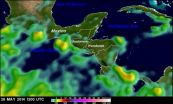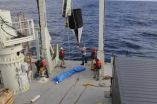(Press-News.org) Stanford, CA— A team of researchers studying a flowering plant has zeroed in on the way cells manage external signals about prevailing conditions, a capability that is essential for cells to survive in a fluctuating environment.
Researchers at UC Berkeley, the Plant Gene Expression Center, UC San Francisco, and the Carnegie Institution for Science identified a novel mechanism by which the strength of such an external signal is reduced, or attenuated. Their work focuses on the tiny mustard plant Arabidopsis, which is frequently used by scientists as an experimental model. Their findings are published in Science June 6.
Attenuation of signaling is analogous to the brakes on a car. While acceleration is desirable, acceleration without restraint can be disastrous. In this research, Arabidopsis seedlings were taken from subterranean darkness into sunlight, which triggered a response leading to "rapid and extensive" redirection of gene expression, ultimately resulting in familiar green seedlings.
But a brake on this acceleration of new gene expression is also necessary to restabilize the cells at a new equilibrium. The research team discovered a nuclear-localized, bimolecular signaling configuration by which the braking mechanism is directly linked to the accelerator, thereby providing simultaneous acceleration and restraint. By identifying the mechanism involved in this attenuation process, the team's discovery has potential implications ranging from agricultural to cancer research.
Cellular signaling triggered by external cues such as sunlight enables organisms to adapt to the prevailing conditions. When the organism perceives something that requires a response, a series of chemical signals is activated. This signaling is generally very robust at first. But at some point it is necessary to dial it back or turn it off entirely—a restraint that falls to different, less-understood signaling pathways. These types of restraint functions are of great importance but poorly understood, as scientists have focused mostly on how the cells get stimulated in the first place.
Light-signaling in Arabidopsis involves the binding of an activated photoreceptor molecule (called phytochrome) to a transcription factor (gene-switch) called PIF. This binding destroys PIF, switching off its target genes. However, the researchers found that in imposing PIF's destruction, phytochrome signs its own death warrant and is simultaneously executed, thus reducing the incoming light-signaling intensity.
"Understanding such molecular mechanisms underlying the light response kinetics is important for engineering crops that can better adapt to environmental fluctuations," said Carnegie's Zhiyong Wang, one of the co-authors.
This bimolecular mutually assured destruction (MAD) mechanism of signaling attenuation appears to represent a new configuration, thus broadening our understanding of the range of mechanisms nature has evolved for this critical function.
INFORMATION:
This work was supported by NIH, DOE, and the USDA.
The Carnegie Institution for Science is a private, nonprofit organization headquartered in Washington, D.C., with six research departments throughout the U.S. Since its founding in 1902, the Carnegie Institution has been a pioneering force in basic scientific research. Carnegie scientists are leaders in plant biology, developmental biology, astronomy, materials science, global ecology, and Earth and planetary science.
MAD: Scientists shed light on braking mechanisms in cellular signaling
2014-06-05
ELSE PRESS RELEASES FROM THIS DATE:
Exploring a legal and ethical gray area for people with dementia
2014-06-05
(Garrison, NY) Many of the legal and ethical options for refusing unwanted interventions are not available to people with dementia because they lack decision-making capacity. But one way for these people to ensure that they do not live for years with severe dementia is to use an advance directive to instruct caregivers to stop giving them food and water by mouth. This is an ethical and legal gray area explored in commentaries and a case study in the Hastings Center Report.
People with decision-making capacity have the legal right to refuse treatment of any kind and to ...
Can virtual reality therapy help alleviate chronic pain?
2014-06-05
New Rochelle, NY, June 5, 2014—Chronic pain due to disease or injury is common, and even prescription pain medications cannot provide acceptable pain relief for many individuals. Virtual reality as a means of distraction, inducing positive emotions, or creating the perception of "swapping" a limb or bodily area affected by chronic pain in a virtual environment can be a powerful therapeutic tool, as described in several articles in Cyberpsychology, Behavior, and Social Networking, a peer-reviewed journal from Mary Ann Liebert, Inc., publishers. The articles are available ...
Cutting edge methods reveal what makes Purkinje neurons unique
2014-06-05
In a collaboration between RIKEN's Brain Science Institute and Center for Life Science Technologies in Japan, scientists combined cutting edge methods to obtain a comprehensive catalogue of proteins that are manufactured in specific parts of Purkinje neurons.
The study, headed by Drs. Thomas Launey, Unit Leader at RIKEN BSI and Charles Plessy, Unit Leader at RIKEN CLST, succeeded in identifying several thousand RNAs that are enriched in rat Purkinje neurons. This comprehensive list holds the key to a better understanding of molecular events within these neurons and potential ...
Restoring trust in VA health care
2014-06-05
(SACRAMENTO, Calif.) — In the wake of recent revelations of overly long patient wait times and systematic manipulation and falsification of reported wait-time data, UC Davis and Harvard public policy leaders believe the Department of Veterans Affairs (VA) health-care system's problems can be fixed by strong leadership, greater transparency and reforms that refocus the organization on its primary mission of providing timely access to consistently high-quality care.
In their Perspective article, published online June 4 in the New England Journal of Medicine, authors Kenneth ...
NASA sees remnants of Tropical Storm Boris merging with Gulf low
2014-06-05
VIDEO:
TRMM satellite data showed that some areas in southwestern Mexico received over 12 inches of rainfall (red) from Boris, while System 90L on the eastern side of Mexico brought similar...
Click here for more information.
The remnants of former Tropical Storm Boris moved over southern Mexico and NASA and NOAA satellite data showed that they were merging with a low pressure area in the southwestern Gulf of Mexico. In addition, data from NASA's TRMM satellite was used to compile ...
New therapy for pancreatic cancer patients shows promising results
2014-06-05
SCOTTSDALE, Ariz. — June 5, 2014 — A clinical trial conducted by researchers at the Virginia G. Piper Cancer Center Clinical Trials, a partnership between Scottsdale Healthcare and the Translational Genomics Research Institute (TGen), showed that a new drug called MM-398, given in combination with 5-flourouracil (5FU) and leucovorin, produced a significant overall survival rate in patients with advanced, previously-treated pancreatic cancer.
The NAPOLI-1 (NAnoliPOsomaL Irinotecan) Phase 3 study — a final confirmation of a drug's safety and effectiveness — was conducted ...
Team finds on-off switch to burning stored fat
2014-06-05
SAN ANTONIO, Texas (June 5, 2014) — Scientists this week reported that a molecular pathway called mTORC1 controls the conversion of unhealthy white fat into beige fat, an appealing target for increasing energy expenditure and reducing obesity. The team, led by researchers from the School of Medicine at The University of Texas Health Science Center at San Antonio, also found that a protein, Grb10, serves as the on-off switch for mTORC1 signaling and the "beigeing" of fat.
The finding could inform development of novel diabetes and obesity drugs, the scientists said. The ...
How do phytoplankton survive a scarcity of a critical nutrient?
2014-06-05
Phytoplankton—tiny, photosynthetic organisms—are essential to life on Earth, supplying us with roughly half the oxygen we breathe. Like all other life forms, phytoplankton require the element phosphorus to carry out critical cellular activity, but in some parts of the world's ocean, P is in limited supply. How do phytoplankton survive when phosphorus is difficult to find?
Phytoplankton can alter their biochemical make-up according to the availability of nutrients in the water. When phosphorus (P) is particularly abundant in the water, phytoplankton produce and store ...
Stimulating a protein in skin cells could improve psoriasis symptoms
2014-06-05
Psoriasis is a common, long-lasting disease that causes itchy or sore patches of thick, red skin with silvery scales. Environmental contaminants can trigger psoriasis and other autoimmune disorders, and it is thought that a protein called the aryl hydrocarbon receptor (AhR), which senses environmental toxins, could play a role. A study published by Cell Press on June 5 in the journal Immunity shows that the severity of inflammation associated with psoriasis is unexpectedly suppressed by AhR. The findings suggest that stimulation of AhR could improve symptoms and may represent ...
Neurons transplanted into Parkinson's-affected brains appear healthy after 14 years
2014-06-05
When transplanted into the midbrains of adult patients with Parkinson's disease, dopamine neurons derived from fetal tissue can remain healthy for many years. The findings reported in the Cell Press journal Cell Reports on June 5th suggest that transplanted neurons don't degenerate over time as some had suggested and feared they would, which provides further rationale for pursuing stem cells as a source for transplant-ready dopamine neurons, according to the researchers.
"Our findings show a robust expression of dopamine transporters and a lack of abnormal mitochondrial ...



